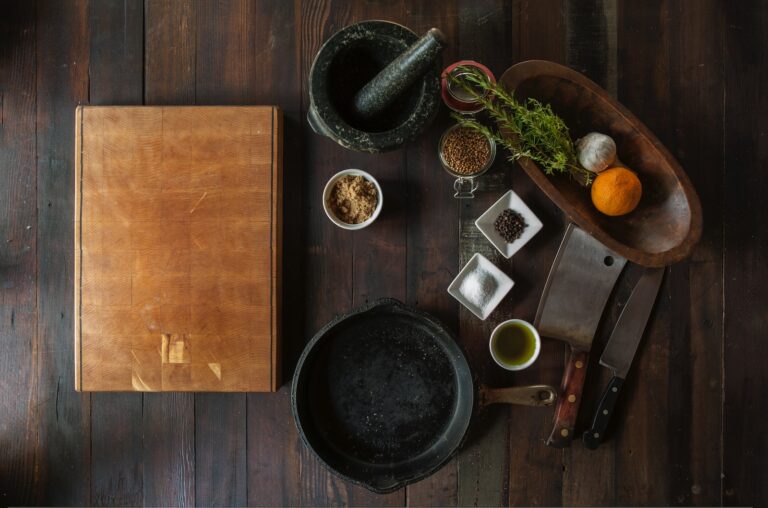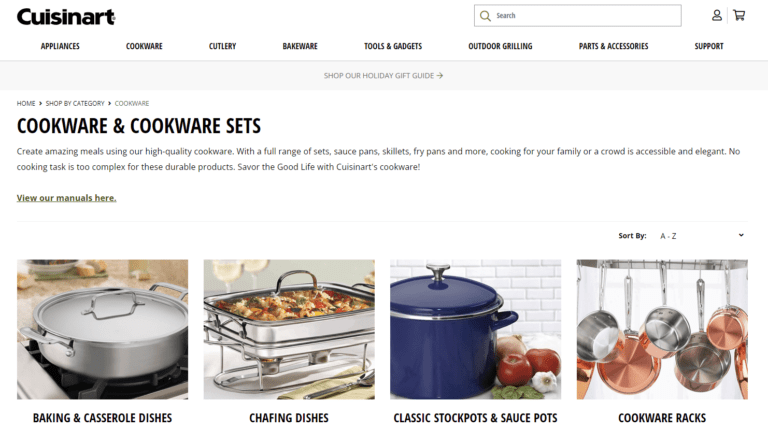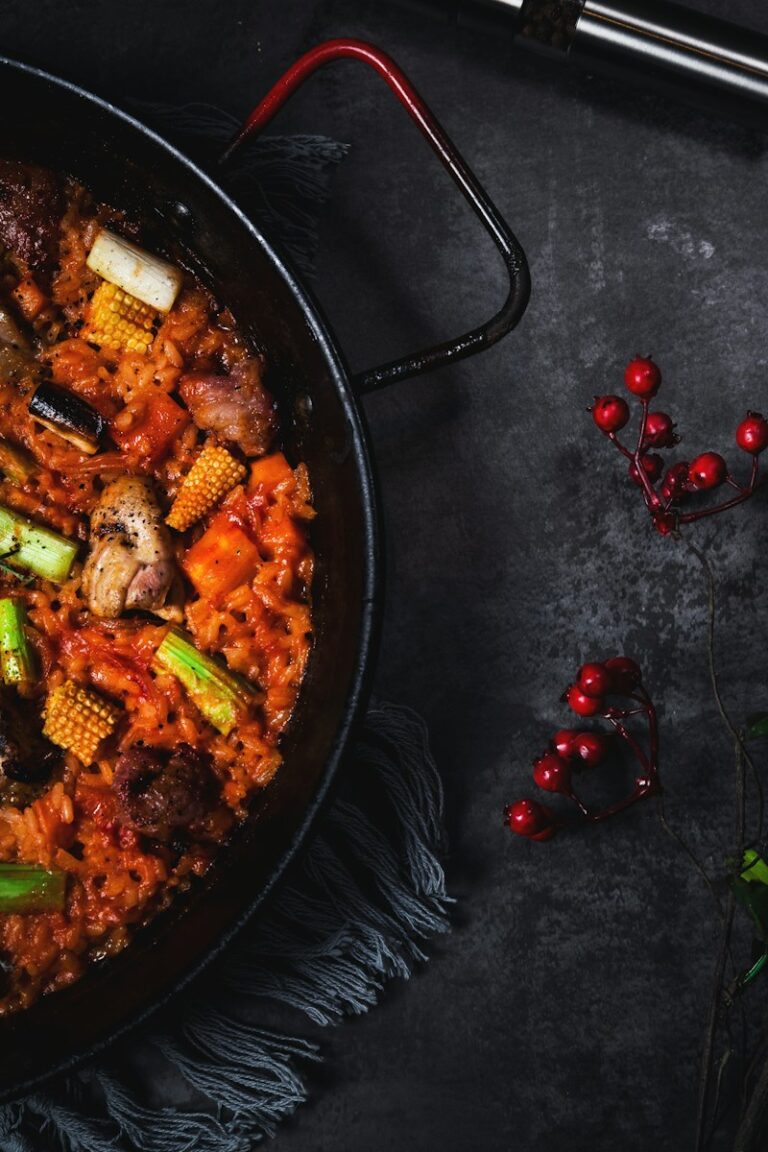I’ve always wondered if my beloved cast iron pans are really sanitary for cooking. In this article, I’ll explore the benefits of using cast iron pans, debunk myths about bacteria, and provide tips on how to clean and maintain their sanitary condition.
Plus, we’ll delve into the science behind their non-stick properties and compare them to other cookware options.
So, let’s put those concerns to rest and discover why cast iron pans are a safe and reliable choice in the kitchen!
Key Takeaways
- Cast iron pans can be cleaned to remove bacteria
- Thorough cleaning after each use is important
- Soap should be avoided as it can strip seasoning
- Proper care and maintenance are required to keep cast iron pans in top shape
Benefits of Cooking With Cast Iron Pans
When you cook with cast iron pans, you’ll experience the benefits of even heat distribution and natural non-stick properties.
I love using my cast iron pans because they heat up quickly and evenly, allowing me to cook my food perfectly every time. Unlike other types of pans, cast iron retains heat well, which means that once it’s hot, it stays hot for a long time. This is especially helpful when searing meat or cooking dishes that require high heat.
Additionally, cast iron naturally develops a non-stick surface over time as it continues to be seasoned with oil and fats. This makes cooking and cleaning up a breeze, as food easily releases from the pan without sticking or leaving residue behind.
Understanding the Seasoning Process for Cast Iron Pans
When it comes to cooking with cast iron pans, understanding the seasoning process is essential. The purpose of seasoning is to create a non-stick surface and prevent rusting. Proper seasoning not only enhances the flavor of your food but also prolongs the lifespan of your cast iron pan.
However, many people make common seasoning mistakes that can affect the quality and performance of their pans.
Purpose of Seasoning
The purpose of seasoning cast iron pans is to create a non-stick surface and enhance their durability. When I season my cast iron pans, I am essentially creating a protective layer on the surface that prevents food from sticking.
This process involves heating the pan, applying a thin layer of oil or fat, and then baking it in the oven. The high heat allows the oil to polymerize, forming a slick coating that makes cooking and cleaning much easier.
Not only does seasoning make my pans non-stick, but it also helps prevent rusting and increases their overall lifespan. With each use and proper maintenance, my seasoned cast iron pans become even more reliable and efficient in the kitchen.
Benefits of Proper Seasoning
Properly seasoning your cast iron pans will make them more durable and improve their non-stick capabilities. I’ve been using this technique for years, and the benefits are remarkable. Here’s why you should consider seasoning your cast iron pans:
- Enhanced Cooking Performance: Seasoning creates a natural non-stick surface, allowing food to easily release from the pan without sticking or burning. This means you can cook delicate dishes like eggs or fish with confidence.
- Rust Prevention: A well-seasoned pan forms a protective layer that prevents rust from forming on the surface. This is especially important if you live in a humid climate or accidentally leave your pan wet.
- Easy Cleaning: The seasoned surface makes cleaning a breeze. Simply wipe off any residue with a paper towel or rinse with hot water – no need for harsh scrubbing or detergent.
Common Seasoning Mistakes
One of the most common mistakes people make when seasoning their cast iron is not applying enough oil. I’ve made this mistake myself in the past, thinking that a thin layer of oil would be sufficient to protect and season the pan.
However, what I didn’t realize is that a generous amount of oil is needed to create a smooth and non-stick surface. When you don’t apply enough oil, the seasoning won’t be able to fully develop, leaving your cast iron vulnerable to rust and food sticking to its surface.
To avoid this mistake, I’ve learned to generously coat my cast iron with oil before heating it in the oven or on the stovetop. This ensures that every nook and cranny gets properly seasoned and helps maintain the longevity of my cast iron pans.
Debunking Myths About Cast Iron Pans and Bacteria
I’ve always heard that cast iron pans can harbor bacteria, but is that really true?
In this discussion, we’ll debunk the myths surrounding bacteria on cast iron and explore the best ways to clean these versatile cooking tools.
Bacteria on Cast Iron
To ensure there are no bacteria on your cast iron pan, make sure to thoroughly clean it after each use. I usually follow these steps when cleaning my cast iron pan:
- Use hot water and a stiff brush to scrub off any food residue.
- Avoid using soap as it can strip away the seasoning of the pan.
- Dry the pan completely with a towel or by heating it over low heat on the stove.
By following these simple steps, I can maintain a sanitary cast iron pan that is free from bacteria.
It’s important to note that proper cleaning and maintenance of your cast iron pan will not only keep it in good condition but also ensure its longevity. So don’t forget to give your cast iron pan some extra TLC after every use!
Cleaning Cast Iron
Now that we know about the bacteria on cast iron, let’s talk about cleaning these pans.
When it comes to keeping my cast iron pan sanitary, I have a simple routine. After each use, I scrub it with hot water and a stiff brush to remove any food residue.
Then, I dry it thoroughly using paper towels or by heating it on the stove for a few minutes. To prevent rusting, I apply a thin layer of oil while the pan is still warm.
This helps to maintain its seasoning and keeps it ready for future use. It may seem like extra work, but with proper care and maintenance, cleaning my cast iron pan is worth it as it ensures its longevity and hygiene in my kitchen.
How to Properly Clean a Cast Iron Pan
Make sure you’re using a gentle scrub brush and hot water to clean your cast iron pan. This is the best way to remove any stuck-on food or residue without damaging the seasoning.
Here are some additional tips for properly cleaning your cast iron pan:
- Avoid using soap: Soap can strip away the protective layer of seasoning on your pan, so it’s best to avoid it altogether.
- Dry thoroughly: After cleaning, make sure to dry your cast iron pan completely. Any moisture left behind can lead to rusting.
- Apply a thin layer of oil: To maintain the seasoning and prevent rust, apply a thin layer of oil after each use. This helps keep your cast iron pan in top condition.
Maintaining the Sanitary Condition of Cast Iron Pans
By regularly cleaning and oiling my cast iron pan, I can ensure that it remains in a hygienic condition for safe cooking. It’s important to understand that cast iron pans require special care to maintain their sanitary condition. Cleaning after each use is crucial to remove any food residue or bacteria. I like to use a mixture of coarse salt and vegetable oil to scrub away stubborn stains. Once clean, I make sure to dry my pan thoroughly to prevent rusting. To further protect the surface and enhance its non-stick properties, I season my pan with a thin layer of oil. This creates a natural barrier against potential contaminants while also adding flavor and depth to my dishes.
| Cleaning Tips | Oiling Tips | Maintenance Tips |
|---|---|---|
| Use coarse salt | Apply vegetable oil | Dry thoroughly |
| Scrub gently | Spread evenly | Store in a dry place |
| Avoid soap | Heat on low | Re-season as needed |
With these simple steps, my cast iron pan remains not only sanitary but also becomes a cherished tool in my kitchen arsenal.
Exploring the Health Benefits of Cooking With Cast Iron
When it comes to cooking with cast iron, there are several health benefits worth exploring.
First and foremost, using a cast iron pan can increase iron absorption in your food, which is especially beneficial for individuals who may have low iron levels.
Additionally, cast iron pans provide a non-toxic cooking surface that doesn’t leach harmful chemicals into your food.
Lastly, one cannot overlook the enhanced food flavor that comes from cooking with cast iron, as it adds a unique and delicious taste to dishes.
Iron Absorption Benefits
Iron from cast iron pans can be absorbed by the body, potentially providing health benefits. As someone who loves cooking with cast iron, I find it fascinating that this simple act can actually contribute to my overall well-being. Here are some reasons why the iron absorption benefits of using cast iron pans are worth considering:
- Increased iron intake: Cooking with cast iron can help boost your daily intake of iron, especially for individuals who may be at risk of deficiency.
- Improved energy levels: Iron is essential for the production of red blood cells and oxygen transportation in the body. By absorbing more iron through cooking with cast iron pans, you may experience increased energy levels.
- Enhanced brain function: Iron plays a crucial role in cognitive development and brain function. The additional iron obtained from cooking with cast iron pans could potentially support optimal brain health.
Non-Toxic Cooking Surface
Using a non-toxic cooking surface is important for maintaining a healthy kitchen environment. As someone who loves to cook, I pay close attention to the materials I use in my kitchen. One of my favorite options is a cast iron pan. Not only does it provide excellent heat distribution and retention, but it also offers a non-toxic cooking surface. Cast iron pans are made from natural materials and do not contain harmful chemicals like some non-stick coatings do. To further illustrate the benefits of using a cast iron pan, here is a table outlining its advantages:
| Advantages of Cast Iron Pans |
|---|
| Excellent heat distribution |
| Superior heat retention |
| Non-toxic cooking surface |
Enhanced Food Flavor
A cast iron pan enhances the flavor of your food by creating a delicious and savory sear. When you cook with a cast iron pan, the high heat retention and even distribution of heat allows for optimal browning and caramelization. This results in a depth of flavor that is hard to achieve with other types of cookware.
The natural non-stick properties of seasoned cast iron pans also help to amplify the flavors by preventing sticking and allowing for easy release.
The porous surface of cast iron pans absorbs oils and fats during cooking, adding an extra layer of richness to your dishes.
The consistent heat provided by a cast iron pan helps to lock in moisture, resulting in juicier and more flavorful meats.
Overall, using a cast iron pan truly elevates the taste experience of your meals, making them more satisfying and enjoyable.
Tips for Cooking and Serving Food Safely in Cast Iron Pans
To ensure food safety when cooking with cast iron pans, it’s important to follow proper cooking and serving guidelines.
When using a cast iron pan, the first step is to properly season it by coating it with oil and heating it on the stove. This creates a non-stick surface and prevents rusting.
It’s also crucial to preheat the pan before adding any ingredients, as this ensures even heat distribution.
When cooking with acidic foods, such as tomatoes or citrus fruits, it’s best to avoid prolonged contact with the pan, as this can leach iron into the food.
Additionally, when serving food from a cast iron pan, always use oven mitts or pot holders to protect your hands from the hot handle.
Addressing Concerns About Rust and Hygiene in Cast Iron Pans
When cooking with cast iron, it’s important to address concerns about rust and hygiene. Cast iron pans are known for their durability and ability to retain heat, but they require special care to maintain their quality. Here are some tips to keep your cast iron pans in top shape:
- Season your pan: Regularly season your cast iron pan with oil or fat to create a protective layer that prevents rust.
- Clean properly: Avoid using harsh detergents or abrasive scrubbers that can damage the seasoning. Instead, gently scrub with a brush or sponge and hot water.
- Dry thoroughly: After washing, make sure to dry your cast iron pan completely to prevent moisture from causing rust.
The Science Behind the Non-Stick Properties of Cast Iron Pans
When it comes to cast iron pans, concerns about rust and hygiene often arise. In my previous subtopic, I addressed these concerns and explained how proper care can keep your cast iron pan clean and rust-free. Now, let’s dive into the science behind the non-stick properties of cast iron pans.
One of the reasons why cast iron pans are prized by chefs is their natural non-stick properties. This is due to a process called seasoning, where a layer of oil polymerizes onto the surface of the pan. This creates a smooth and slick coating that helps prevent food from sticking.
To understand this process better, let’s take a look at the table below:
| Component | Function | Effect on Non-Stick Properties |
|---|---|---|
| Heat | Opens up pores in the metal surface | Enhances seasoning process |
| Oil/Fat | Polymerizes when heated | Forms a protective non-stick layer |
| Repeated Use | Adds layers to the seasoning | Improves non-stick performance |
Comparing the Sanitary Features of Cast Iron Pans to Other Cookware
Comparing the cleanliness of cast iron pans to other cookware can help you make an informed decision about which type of cookware is best for your kitchen. When it comes to sanitation, here’s what you need to know:
- Cast iron pans require proper care and maintenance to stay clean. They should be seasoned regularly and washed with mild soap and water.
- Non-stick pans are easy to clean as they have a smooth surface that prevents food from sticking. However, they may scratch easily if not handled properly.
- Stainless steel pans are generally considered more sanitary as they don’t react with acidic or alkaline foods. They can be cleaned in a dishwasher but may require scrubbing for stubborn stains.
Considering these factors, it ultimately depends on your personal preference and cooking style when choosing the most sanitary cookware for your kitchen.
Expert Advice on Using Cast Iron Pans for All Your Cooking Needs
When it comes to using cast iron pans for all my cooking needs, I always seek expert advice.
Over the years, I’ve learned that these versatile pans are not only durable but also provide exceptional heat distribution. They can be used on a variety of stovetops and even in the oven.
The key is to properly season your pan before use, creating a natural non-stick surface that improves with time and use. Additionally, experts recommend avoiding harsh detergents and opting for gentle cleaning methods like using hot water and a brush or scraper. This helps maintain the seasoned coating while ensuring cleanliness.
Exploring the Historical and Cultural Significance of Cast Iron Cookware
The historical and cultural significance of cast iron cookware can be seen in its widespread use across different cuisines and generations. Growing up, I remember watching my grandmother effortlessly cook delicious meals in her trusty cast iron skillet. It was a staple in our kitchen, passed down through the generations. Cast iron pans have stood the test of time for good reason.
Here are three reasons why they hold such importance:
- Durability: Cast iron pans are known for their durability and longevity. They can withstand high temperatures without warping or breaking, making them perfect for searing, frying, and baking.
- Heat retention: Cast iron has excellent heat retention properties, ensuring even cooking throughout your dishes.
- Flavor enhancement: Over time, the seasoning on cast iron pans adds a unique flavor to your food that cannot be replicated by any other type of cookware.
These qualities have made cast iron cookware an integral part of culinary traditions around the world.
Conclusion
In conclusion, I can confidently say that cast iron pans are indeed sanitary. After researching and understanding the benefits of cooking with cast iron pans, debunking myths about their sanitary condition, and learning how to properly clean and maintain them, it is clear that they provide a safe and healthy cooking experience.
With their non-stick properties and ability to withstand high temperatures, cast iron pans are a reliable choice in the kitchen. They offer a versatile cooking surface that can be used for a wide range of dishes. Whether you’re searing a steak, baking cornbread, or frying eggs, a cast iron pan can handle it all.
Furthermore, cast iron pans have been used for centuries and have stood the test of time. They are durable and can last for generations with proper care. This makes them a sustainable choice in the kitchen, reducing the need for frequent replacement and minimizing waste.
So next time you’re in the kitchen, don’t hesitate to reach for your trusty cast iron pan. Enjoy all the delicious meals it can help you create, knowing that you are cooking in a sanitary and reliable cookware option.




